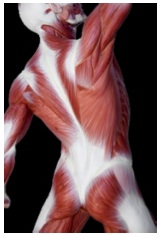The Causes of Lower Back Pain
|
The causes of lower back pain is hotly debated across numerous medical fields and disciplines. But if set aside the incidence of traumatic injury, and we look at the body as a wholistic structure, we can see that the causes of pain can be broken down into five primary problems. |
 |
Causes of Lower Back Pain:
Five Primary Problems
1. Ischemia
(pronounced: Iz skeem ee ah)
The first cause of lower back pain is ischemia.
"Ischemia" means lack of blood. Without an adequate blood supply, the tissues of the body such as muscles cannot function properly.
Without adequate blood to provide food and oxygen, soft tissues such as muscles, tendons, ligaments, and fascia build up lactic and other acids and become painful.
Ischemia occurs when muscles are chronically contracted over a period of time. Such chronic contraction can occur as a consequence of habitual functional patterns, structural imbalance, injury, or some combination of these forces.
2. Myofascial Trigger Points
The second cause of lower back pain is myofascial trigger points.
A trigger point is an area of the soft tissue which, after chronic contraction and reduced blood flow, becomes an area of high neurologic activity.
For example, certain fibers in an ischemic muscle (a muscle with low blood) can become an active trigger point in response to biochemical changes in the tissue.
Active trigger points cause referred sensation to other parts of the body. That sensation can be pain, tingling, numbness, thermal sensations (hot or cold), weakness, a general achy quality, or the feeling that "it just doesn't feel right."
For example, you might have a trigger point in a muscle of your lower back which refers sensation down into your buttocks, or even down the leg.
This is NOT
same thing as the referred pain caused by nerve compression and nerve
entrapment which will be covered next.
See more about trigger points...
3. Nerve Compression & Nerve Entrapment
The third cause of lower back pain is nerve compression and entrapment.
Nerve compression is the pressure put on a nerve by a bone or an intervertebral disc.
Nerve compression occurs when the spine becomes misaligned for some reason (faulty movement patterns, injury, chronic muscular tightness) and one of the discs between the vertebrae get squeezed on one side so that it bulges out the other side.
If the bulging disc puts pressure on a spinal nerve, then you’ve got pain!
Nerve entrapment is when a nerve is caught or pinched by the soft tissues.
For example, the sciatic nerve (the largest nerve in the body) runs down through the buttocks and can become entrapped by the piriformis muscle when that muscle is very tight.
This can result in pain down the back of the leg.
4. Postural Distortion
(aka Structural Imbalance)
The fourth cause of lower back pain is postural distortion.
In a sense, this issue is the most significant of all. The reason for that lofty status is due to the fact that postural distortion is often the root problem responsible for ischemia, trigger points, and nerve compression or entrapment.
If the body is distorted off its center line of gravity, compensating muscular patterns can result.
To illustrate the point, put your elbow on the table in front of you with your forearm pointed straight up to the ceiling.
Now imagine you’ve got a bowling ball resting in your palm.
If your forearm is completely straight up and down, the weight of the bowling ball will be supported by the bones of your forearm. Theoretically, you could hold that bowling ball there indefinitely.
But if you shifted off that center line, even a tiny bit, then the muscles of your arm would have to engage in order to hold up the bowling ball.
Even the strongest human in the world wouldn’t be able to hold that ball there for long.
This is precisely what can happen with your body.
If your alignment is off such that your head is not centered over your shoulders, hips, knees, and feet, then muscles throughout your body must perpetually engage in order to hold you up.
This can lead to muscular compensation patterns that, over time, can become painful.
See more about postural distortion...
5. Dysfunctional Biomechanics
The fifth cause of lower back pain is dysfunctional biomechanics.
This is often a secondary result of postural distortion and is evidenced by faulty movement patterns.
For example, if you’ve got nagging lower back pain you might hold your body in a restricted way, walk differently, or reach for things with limited range of movement.
It’s logical to do that and natural to not fight against your body’s self-imposed limitations. The body trying to protect you from pain. Until the postural distortion is addressed, and the pain is relieved, there’s wisdom in those limits.
However, repetitive movements can become patterned into your nervous system such that, even after postural and muscular problems have been eliminated, you still move in a limited, protective way.
This can perpetually revive structural and muscular imbalances. That’s why even a minimum regime of daily stretches can be vital to full recovery.

|
CURRENT COURSES POSTURAL BLUEPRINT FOR CORRECTING PELVIC TORSION: The Complete Guide To Restoring Pelvic Balance (2022) STRETCHING BLUEPRINT FOR PAIN RELIEF & BETTER FLEXIBILITY: The Complete Guide to Pain-Free Muscles Using Active Isolated Stretching (2020) HEALING THE HIDDEN ROOT OF PAIN: Self-Treatment for Iliopsoas Syndrome (2013) FREE MINI COURSE: Introduction to Active Isolated Stretching |

